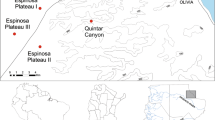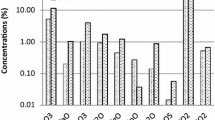Abstract
This paper reveals the geochemical processes of dissolution, precipitation and cation exchange that took place during water–rock interaction between water seepages through the Tannur Dam. The Schoeller diagram indicates that there are three major water types originating during water–rock interaction. The first water type is characterized by low salinity that ranges from 1,300 to 2,800 µs/cm, which represents the reservoir water and the water in the right side of the central gallery. The second water type is in the left side of the central gallery, which exhibits medium salinity that reaches about 4,400 µs/cm. The third water type is characterized by very high salinity that reaches a value of around 8,500 µs/cm and represents the water in the right existing adit. The increase of salinity can be explained due to the dissolution of carbonate and sulfate minerals that form the matrix of the foundation and the abutment rocks, and the dissolution of the grout curtain, which is composed of cement and bentonite. Hydrogeochemical modeling, using a computer code PHREEQC, was used to obtain the saturation indices of specific mineral phases, which might be related to interaction with water seepages, and to identify the chemical species of the dissolved ions. The thermodynamic calculations indicate that most of the water samples were undersaturated with respect to gypsum, anhydrite and halite, and were saturated and/or supersaturated with respect to calcite and dolomite. Ca(HCO3)2 is the primary water type, as a result of dissolution of carbonate minerals such as calcite and dolomite prevailing at the dam site. However, cation-exchange processes are responsible for the formation of the Na2SO4 water type from the CaSO4 type that formed due to the dissolution of gypsum.














Similar content being viewed by others
References
Adams S, Titus R, Pieterson, K, Terdoux G, Harris C (2001) Hydrochemical characteristic of aquifers near Sutherland in the Western Karoo, South Africa. J Hydrol 241:91–103
Amireh BS, Abed AM (2000) Depositional environments of the Kurnub Group (Early Cretaceous) in northern Jordan. J Afr Earth Sci 15:87–102
Arnold D, Greenberg, L Clesceri, Andrew, D (1992) Standard methods for the examination of water and wastewater, 18th edn. American Public Health Association, Washington, DC
Bender F (1974) Geology of Jordan, supplementary edition in English with minor revision. Gebr Borntraegger, Berlin
Freeze AR, Cherry AJ (1979) Groundwater. Prentice-Hall, Englewood Cliffs, NJ, USA
Furtak H, Langguth RH (1967) Zur hydrochemischen Kennzeichnung von Grundwässertypen mittels Kennzahlen. Int Assoc Hydrogeol Mem 7:89–96
Howard Humphreys and Partners (1995) The study and design of Tannur Dam. Draft final report, vol I, site investigation. Internal Rep Jordan Valley Authority of Jordan, Amman
Keckler D (1999) Surfer: contouring and 3D surface mapping. Golden Software Inc, Colorado, USA
MacDonald M (1999) Tannur Dam site visit report. JP Beveridge, for Jordan Valley Authority
MacDonald and Partners (1965) East Bank water resources of Jordan. Report and maps. Hunting Technical Services Ltd, Water Authority of Jordan, Amman
Parkhurst D, Thorstenson D, Plummer L (1980) PHREEQE—a computer program for geochemical calculations. US Geol Surv Water Resources Invest 80-96
Piper AM (1944) A graphic procedure in geochemical interpretation of water analysis. Trans Am Geophys Union 25(6):914–928
Rockware Inc (1999) Rockworks: a computer program for integrated geological data management, analysis & visualization. Rockware Inc, USA
Swan RH, Sandilands M (1995) Introduction to geological data analysis. Blackwell, Oxford
Swancar A, Hutchinson CB (1992) Chemical and isotopic composition and potential for contamination of water in the Upper Floridan aquifer, west-central Florida. US Geol Surv Open-File Rep 92-47
Tedaldi DJ, Loehr RC (1992) Effects of wastewater irrigation on aqueous geochemistry near Paris, Texas. Groundwater 30(5):709–719
WAJ (1999) Internal files of the wells data in the Jordan Valley area. Water Authority of Jordan
Author information
Authors and Affiliations
Corresponding author
Rights and permissions
About this article
Cite this article
El Naqa, A., Al Kuisi, M. Hydrogeochemical modeling of the water seepages through Tannur Dam, southern Jordan. Env Geol 45, 1087–1100 (2004). https://doi.org/10.1007/s00254-004-0967-6
Received:
Accepted:
Published:
Issue Date:
DOI: https://doi.org/10.1007/s00254-004-0967-6




